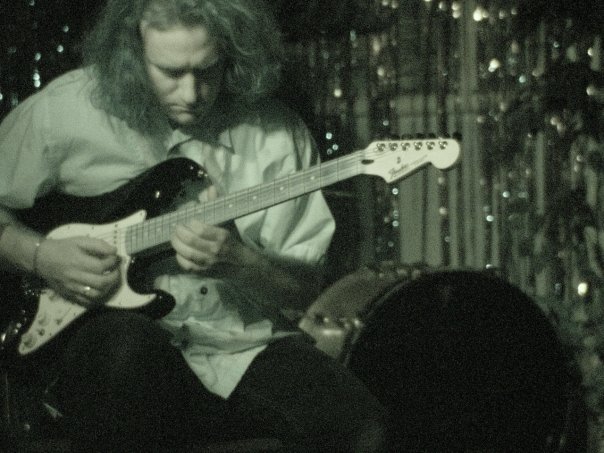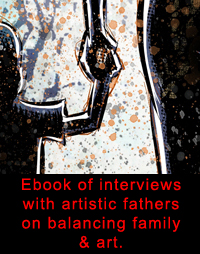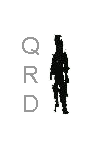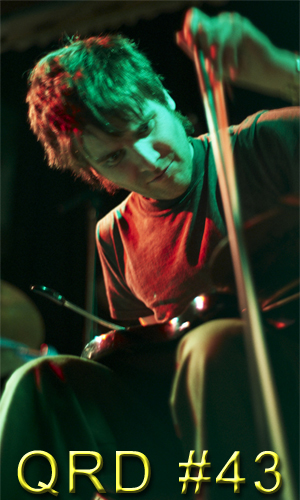
August 2010
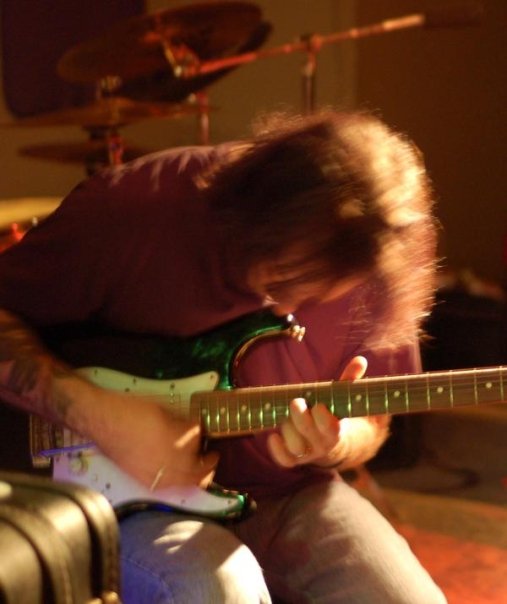
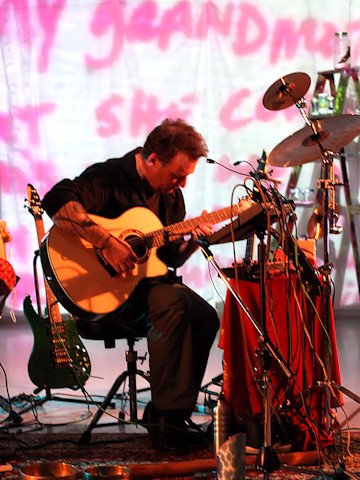
Name: Eric Hausmann
Bands: solo projects, Brainwarmer, Tres Gone, Dead Air Fresheners
Websites: Facebook, spillingaudio.com, twitter.com/hausmann, erichausmann.bandcamp.com, myspace.com/spilling, vimeo.com/hausmann
Listen to “Dub Squad”
Listen to “BOR Factor”
Listen to “Saint Helen”
Listen to “Took”
QRD – What was your first guitar & what happened to it?
Eric – My very first guitar was a half-size acoustic from a department store. I’m not sure what happened to it, but I remember taking it all apart so I could spray paint it metallic black.
QRD – What’s your typical set-up from guitar to effects to amplifier?
Eric – It varies quite a bit for each instrument, the style of music & if it’s for live or a recording session. A couple of effects I always like to have in the chain are phase shifter, reverb, & delay.
QRD – What’s the most important part of your rig: guitar, amplifier, or effects?
Eric – Absolutely the Roland VG-99. It’s the heart of most of my sounds.
QRD – What’s your main amplifier & why?
Eric – Playing live, I have a pair of Roland KC-500 amps. They are full range amps so I use these specifically for the stereo output of the Roland VG-99. When I don’t need to lug around something so large, I use little ZT Lunchbox amps. They are tiny & extremely powerful.
QRD – What’s your main guitar & what are the features that make it such?
Eric – My main guitar is a Brian Moore iGuitar 91.13. Mahogany body, rosewood fretboard. It has 2 humbuckers & a single coil in the middle. In addition it also has an RMC piezo pickup for acoustic sounds which are separately outputted via a stereo output. This guitar also has built-in USB & a 13-pin jack for accessing MIDI devices such as the Roland VG-99.
QRD – If you had a signature guitar, what would it look like & what would some of its features be?
Eric – That’s a tough one. I love the gadgetry. Effects, coil tapping, tremolo bars. But somehow, I think my ultimate guitar may be more attractive to me in a more organic way. Perhaps a fat hollow body with a single mini humbucker. A piece of wood that just feels right.
QRD – If you had a signature pedal, what would it be & what would some of its features be?
Eric – I don’t use stomp boxes very often since everything I need is all controlled out of one box, but the one pedal I always use is a simple volume pedal. I’ve never found one I like. The closest is the Ernie Ball, which has a nice weight to it. But I would take this design & give it a longer throw & a base that is wider than the actual pedal. Then it would be perfect! (for me, anyway)
QRD – How many guitars do you own?
Eric – I have 16 guitars, including basses. I’m in the process of selling some though.
QRD – How & where do you store your guitars?
Eric – They are mostly kept in their cases, except for an assortment of 3 or 4 I tend to keep nearby when I’m recording.
QRD – What do you wish guitar cases had that they usually don’t?
Eric – I’m fine with cases the way they are. I only use them to hold the guitar & don’t usually keep anything else in there. Some of my guitar cases are missing latches though.
QRD – What features do you look for when buying a guitar?
Eric – I’m a sucker for weird, unconventional electrics, like Japanese budget guitars from the 70s. Some of them have good construction, cool colors, & fun designs. I’m drawn to things like big rocker switches, lots of buttons, weird shapes.
QRD – How much do you think a good guitar should cost?
Eric – If you wanted a guitar with rare tone woods, you’re obviously going to pay a heck of a lot more than a machined ash body Tele. Then there’s all the rest of the bazillions add-ons & options. It can quickly get quite expensive. But I think some of the mass-produced guitars coming from factories in Korea, Indonesia & China are getting better & better. Not exceptional, but very solidly built & nice playing guitars that rival guitars two or three times the price. Last year I purchased a guitar by a Korean company by the name Rally & for a few hundred dollars, I have this beautiful new flame-top maple guitar with very nice details & it’s a great feeling guitar.
QRD – Do you upgrade & customize your guitars or just stick with what you get?
Eric – Sometimes. I change pickups a lot. Some guitars I like changing more aesthetic things like pickguards, knobs, etc.
QRD – How thoroughly do you research or test a piece of equipment before buying it?
Eric – I usually read as many reviews as I can.
QRD – Do you change your rig around often?
Eric – Not too drastically. I’m pretty happy with the rig I’ve got now. I do tweak my patches a lot, looking for new sounds to work with or tweaking existing ones.
QRD – Are you after one particular guitar tone & locking into it, or do you like to change your tone around a lot?
Eric – I have a handful of sounds that I use regularly, but I do like to try working with new sounds.
QRD – What are some guitars, amps, & pedals you particularly lust after?
Eric – The Moog guitar is fascinating. I also like the Gibson Robots. I would like to get my hands on a Mohan Veena. There’s also an instrument someone recently told me about called a Sympitar. Basically, it’s an acoustic guitar with the addition of resonating sympathetic strings like you would find on a sitar. The sympathetic strings run beneath the fingerboard & pass below the soundhole. It’s a beautiful instrument, each one custom made by a luthier named Fred Carlson. It’s fascinating & they look like beautiful instruments. Someday.
QRD – What do you think are some important features to be on a person‚s first guitar that aren’t always there?
Eric – Like any instrument, it should at least be made with some measure of quality. It should stay in tune & not be overly difficult to play on. Otherwise, someone learning may become discouraged.
QRD – What have been the best & worst guitar related purchases you’ve made?
Eric – I bought a Dean 5-string acoustic bass a couple of years ago. To call it firewood would be mean to firewood.
QRD – What are some effect, amp, & guitar brands you particularly like or dis-like & why?
Eric – There are a lot of good things out there by a lot of different companies. It’s pretty easy to give you a few names I’m not very fond of. Dean (see above), some Behringer items are poorly-designed.
QRD – What’s the first thing you play when you pick up a guitar?
Eric – The low E string, an open strum, harmonics.
QRD – How old were you when you started playing guitar?
Eric – I started playing at age 13.
QRD – At what age do you think you leveled up to your best guitar playing?
Eric – I’m still learning, & I honestly feel I’m a better player now than I was last year.
QRD – Why do you think a guitar fits you more so than other instruments?
Eric – I play a variety of instruments; some better than others. My percussion skills are getting better all the time, but I’m more at home with a guitar than anything else.
QRD – Do you think guitar should be people‚s first instrument as often as it is?
Eric – I think learning any instrument is a very rewarding experience. My first instrument was the violin.
QRD – Do you see your guitar as your ally or adversary in making music?
Eric – Sure, it’s an ally.
QRD – Who are the guitarists that most influenced your playing & sound?
Eric – Although I don’t think I really sound anything like them (or at least not in an obvious sort of way), I’m heavily influenced by Adrian Belew, Pat Metheny, Neil Young, Bill Laswell, Steve Tibbetts, Joe Perry.
QRD – Do you think people anthropomorphizing their guitars is natural or silly (e.g. naming their guitar)?
Eric – To each his/her own. I don’t name my guitars. Although I could think of a few choice names for that Dean acoustic bass.
QRD – What’s the most physical damage you’ve done to a guitar & how did you do it?
Eric – I was practicing with my band when I was about 17 or so. We were rehearsing on the stage where we were to have a show the following week. I took a few steps backwards while playing & didn’t realize where the edge of the stage was, right behind me. I took a hard drop to the floor & the headstock of my guitar struck the side of my head. I was bleeding from a cut above by my eye, but the guitar fared much worse. The neck bolts pried away from the body of the guitar, pulling wood with it, & leaving the neck bent forward & destroyed. Ta-daa!
QRD – What do you do to practice other than simply playing?
Eric – I sometimes read about guitar techniques & I like looking at chord charts & scales. Sounds nerdy & I guess it is, but scales, in particular, are interesting if you can hear what the notes sound like by looking at them. Sadly, I’m not able to do that with printed chords.
QRD – How many hours a week do you play guitar & how many hours would you like to?
Eric – Not enough. Some weeks I barely play at all & then other weeks I’m deep in a project that has me playing a lot.
QRD – What type of pick do you use & why?
Eric – I like standard thin picks, like Fender thins or anything similar. I feel very uncomfortable trying to play with a rigid pick.
QRD – What gauge strings do you use & why?
Eric – It depends of the guitar but for the most part I use 10s. It’s just what I’m comfortable with & I like the tone of thicker strings.
QRD – How often do you change strings?
Eric – On a guitar I play more frequently, about once every 5 or 6 weeks. If it wasn’t such a pain, I’d change them every week. I love playing with new strings.
QRD – How often do you break strings?
Eric – Almost never. I can’t even remember the last time I busted a string. Fat strings & a thin pick probably helps.
QRD – Which do you feel is more proficient, your strumming hand or fretting hand & how does that effect your style?
Eric – Interesting. Definitely my fretting hand. Just for fun, I like to play things one-handed on the fretboard. I think it’s good exercise & practice. My picking hand could use a lot more work.
QRD – Do you set-up your guitar yourself or send it to a guitar tech (or not set it up at all) & why?
Eric – Some things I do myself. I can make basic adjustments & whatnot, but for more involved work, I take my guitars to a little shop called 12th Fret here in Portland. I’ve been taking guitars there for many years & they always do a superb job.
QRD – What tunings do you use & why?
Eric – In addition to EADGBE, I also like DADGAD. And sometimes I even use BAGDAD, which I tuned to as a joke, but then I started liking it. Joni Mitchell uses a lot of interesting tunings I’d like to experiment with.
QRD – Do you prefer tablature, sheet music, or some other notation system for writing down your own ideas?
Eric – I scribble notes all over the place on a nearby piece of paper. I’m not sure they would be easy to understand. Sometimes I find old pieces of paper I was writing on & think, “What the heck is all this?”
QRD – How high do you hold your guitar when playing (strap length)?
Eric – When I was younger, I used to play with the guitar hung real low because I thought it was cool… very Jimmy Page. Now I keep it right around the mid section. It’s a comfortable place for the guitar to be. But when playing acoustic, I really like to lean into it, hunched over & keep the thing real close.
QRD – What’s a bad habit in your playing you wish you could break?
Eric – I play in the key of E too often. It’s just because I love the resonance of a guitar ringing with open strings. I’ll bet that would change immediately if I started playing on a 7 or 8 string guitar.
QRD – Playing what other instrument do you think can most help someone‚s guitar playing?
Eric – I think probably any other instrument can help. I think it really depends on what you’d like to accomplish.
QRD – What’s a type of guitar playing you wish you could do that you can‚t?
Eric – Fingerpicking. I still don’t know how to fingerpick.
QRD – What’s a guitar goal you’ve never accomplished?
Eric – Does owning a 1957 Les Paul goldtop count?
QRD – What’s the last guitar trick you learned?
Eric – I’m not really into guitar tricks per se. I do however enjoy learning new phrases & chords though.
QRD – What’s your favorite guitar gadget (ebow, capo, slide, string cutter, etc)?
Eric – I love the bow, & my small glass slide.
QRD – What’s a guitar technique you‚d like to master, but haven‚t?
Eric – Playing like Prasanna. He plays in a very different way. Let’s just say, you’ll need several cans of the aerosol product Fingerease to even attempt it.
QRD – Did you ever take guitar lessons & if so, what did you learn from them?
Eric – I took a few lessons when I was a teenager. I didn’t really learn anything from them. I’m completely self-taught.
QRD – What would you teach someone in a guitar lesson that you don’t think they would generally get from a guitar teacher?
Eric – Probably something fun, like how to mess around with controlled feedback.
QRD – What’s something someone would have to do to emulate your style?
Eric – The main ingredients are a volume pedal, stereo reverb, & a phaser.
QRD – What’s your take on tremolo systems?
Eric – I like hearing a tremolo well implemented. You can do so many cool things with a tremolo bar. But even after all these years, I still feel like the tremolo bar is this long stick that is distracting & cumbersome. Then I saw Junior Brown play. He has no trem arm, but he sometimes grabs the bridge with his fingertips & pries it forward. I’ll sometimes do that but I’m also not comfortable with that either. I want a short, stubby tremolo knob instead of an arm. Maybe I’ll just take one & saw it in half.
QRD – How often do you adjust your tone knob?
Eric – If I’m not playing through the VG-99. If my rig is something more conventional, like a guitar straight to a tube amp, I will often roll it back about halfway. I don’t adjust it very often while playing.
QRD – If a band has good guitar work, can you ignore the rest of the band not being good?
Eric – Sometimes. I do have difficulty listening to guitar players who are technically very good, but are putting out really bad music. In the end, sometimes it doesn’t matter how good or bad you are. If you have good ideas & are able to convey them effectively, you can produce an amazing piece of music.
QRD – What famous musician‚s guitar would you like to own & why?
Eric – Pat Metheny’s Pikasso guitar. An acoustic guitar with 42 strings & 3 necks.
QRD – Who do you think is currently the most innovative guitar player & why?
Eric – It’s not easy to narrow it down to one, so I’ll give a couple of examples. Adrian Belew - he’s an obvious choice. He’s not only a very very good player, but he has created more cool sounds than just about anyone in some very unconventional ways. Same goes for Fred Frith. David Torn - he combines organic & electronic elements into wild textural sounds. And he is more innovative with a tremolo arm than I could have ever imagined possible.
QRD – Where can people hear your best guitar work?
Eric – Probably on my latest release, “Slow Ambient Dub.” As you may well imagine, judging from the title, it’s not like a constant guitar in your face sort of listening experience, but since it’s the latest work I’ve done, I think it probably represents some of my better playing.
QRD – Anything else?
Eric – Don’t slip on the ice & watch out for rockets.
